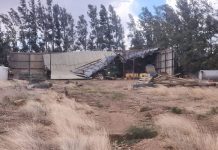
Receiving their training mostly through the Southern African Wildlife College in Hoedspruit, Limpopo, the EMs qualify as either armed or unarmed field rangers to be deployed in government conservation areas throughout SA. To date the EPIP has trained and deployed 1 659 EMs.
Key objectives of the EPIP are to provide additional support to existing conservation corps through patrols and monitoring, and to provide the capacity to conservation communities in order to enhance their mandate for biodiversity and ecosystems services.
Dr Guy Preston, the DEA’s deputy director-general of environmental programmes, said that in addition to their law enforcement activities,
EMs “are the eyes and minds that can help to address multiple threats to the environment, including invasive alien species, wetland degradation, unwanted veld fires, soil erosion, path degradation, dangers posed by fencing breaches, and other impacts”.
iSimangaliso CEO, Andrew Zaloumis, welcomed the “additional 30 pairs of boots on the ground working with seasoned Ezemvelo KZN Wildlife field rangers” in the park.
“Our trainee cadets are a valuable asset and we appreciate being part of the department of environmental affairs’ programme.”











